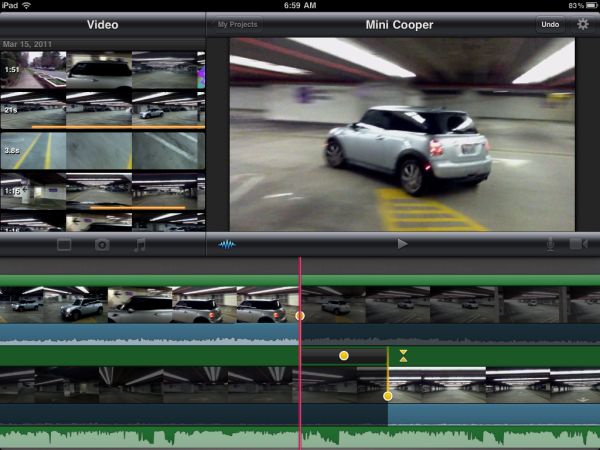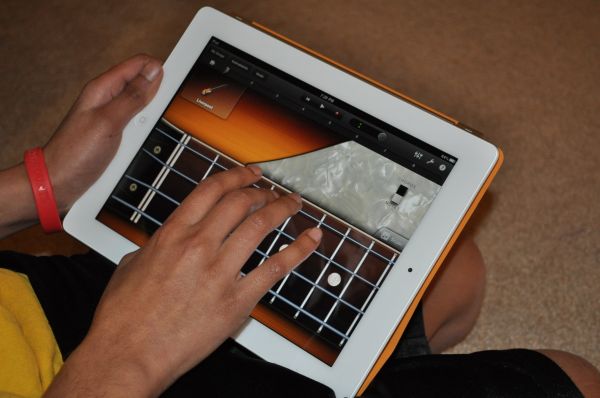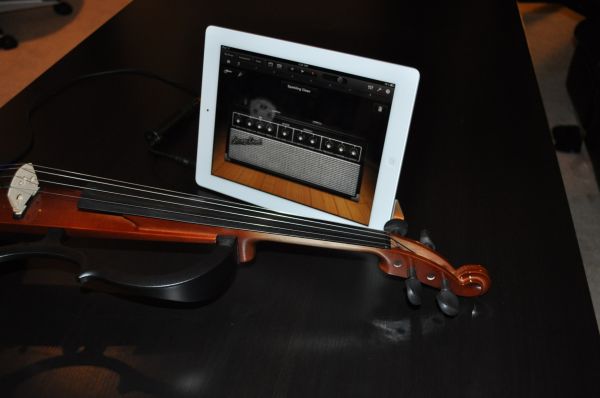The Apple iPad 2 Review
by Brian Klug, Anand Lal Shimpi & Vivek Gowri on March 19, 2011 8:01 PM ESTiMovie
by Vivek Gowri
Apple launched two new content-editing apps along with the iPad 2 - GarageBand and iMovie. iMovie is a $4.99 app available exclusively for iPad 2 (an updated iPhone 4/iPod touch 4 equivalent was launched simultaneously), so I'll start there.
iMovie basically lets you do a decent amount of video editing on the iPad itself. You can edit videos shot on the iPad, or video content imported from SD card using the camera connection kit. Unfortunately as we discovered in our testing, nearly all other sources of video aren't supported by iMovie. If you have grand visions of doing all of your video editing on the iPad 2 you'll want to hit the reset button on your expectations (or wait a few years until it's actually possible). Honestly, I can only see myself using it for video shot with the iPad, it makes the entire video editing process very streamlined on the device and makes video editing something you can do on the go. Just to test it out, I shot a series of videos of my car and stitched them together using iMovie, then added some titles and a soundtrack.
Being able to touch and swipe through the video clips and change the transitions and video cut points using a tactile input method actually makes it a lot easier to use than one would expect. Swipes and gestures rule the day, and it's a great way to edit various clips and put them together in a cohesive manner.
There's not a lot in the way of different options to deal with crossfades and transitions between clips, but the cross dissolve transition that is used as a default is pretty decent for amateur quality videos, especially since you can edit the length of the transition, and the various theme-specific transitions work too, if a little bit tacky.
But this is a video editing app for a 1.3lb tablet; considering that fact, you can get some pretty solid quality video out of it at the end. I'm pretty pleased with the video that I got out at the end, take a look for yourself.
You get a decent number of export options - Facebook, Youtube, Vimeo, CNN iReport (there's a CNN iMovie theme that can be added to videos as well), iTunes, and Camera Roll. From the camera roll, you can copy it to a computer and basically do whatever you want with it. iMovie isn't going to replace any serious video editing application, but I can see it being very useful during CES or another tradeshow - shooting video on the iPad, cutting it down, adding a few transitions, and uploading it in a matter of minutes, all from the same device.
Garage Band
by Vivek Gowri
GarageBand is a new app that Apple is releasing for both generations of iPad, for the same $4.99 price as iMovie, and beyond the basic premise of creating audio tracks from scratch, it's actually not that similar to the desktop app.
Apple has loaded a few instruments in GarageBand - a set of piano and keyboard options, a few drum kits, a vocal sampler/audio recorder from the mic, and even a virtual guitar amp, but the real story is the "Smart Instruments" that they have included.
Meet my brother, Gokul Gowri. He's 12, in 7th grade, and plays violin and piano at a relatively high level. I handed him my iPad 2 with GarageBand and asked him for his impressions.
After messing around with the included piano, he started experimenting with Smart Instruments. The first thing he said was that Smart Instruments could basically play the instrument for you, making good sounding audio clips and multilayered tracks easy to compose for even non-musically inclined people. There are four Smart Instruments - Piano, Bass, Guitar, and Drums. The Guitar is probably the most impressive one of the lot, with 6 strings and the ability to pick or strum at them. The cool part though, is that Smart Instruments will add the chords for you. They're preset chords and unfortunately, users can't define their own chords. That would let more advanced musicians really customise the guitar to their liking (my brother abandoned the smart chords really quickly after discovering he couldn't change them). The nice thing is that you can turn them off and pick your notes on the 6 strings individually. Smart Bass is exactly the same, except it's a four string bass instead of a guitar.
Smart Piano works similarly in that it takes away the actual keys and gives you a pad to press to get the note, with an option to sustain the notes. Smart Drums is another interesting one - you're provided with a grid dependant on volume and pattern complexity that you drag the various drum elements onto to generate a full rhythm.
And then of course, there's autoplay. Press the note, it'll play an entire clip for you, with the complexity of the clip depending on the level of autoplay selected. It's pretty cool if you're not a music person, but if you are, you can actually produce an interesting rhythm with the different options in Smart Instruments. There's a maximum of 8 tracks allowed, and you can duplicate and loop them to create a full song.
My brother decided to hold an impromptu recording session and ended up with this:
It sounds pretty good, especially considering that it was produced by a 12 year old on an iPad in 30 minutes. What my brother ended up doing is layering all four smart instruments to start, then adding in some included loops of orchestra strings to generate the second half of the clip. Pretty simple stuff, which is the goal behind GarageBand - allowing users to create complex sounds using simple musical constructs.
I personally was more curious about the virtual guitar amp. I'm a violinist who's been using an electric for the last couple of years, and I was curious to see if I could actually make use of the amp. I thought Apple would be using some form of line-in 3.5mm connector, but unfortunately, you have to get an external device to connect the electric guitar/violin. Apple recommends Apogee's Jam, though the AmpliTube iRig also works. I picked up an iRig ($39) to test out, since it's significantly cheaper than the $99 Apogee Jam, but the Jam is a studio quality device, so it's probably worth the extra money if you're really serious about it.
Unfortunately, the amp itself isn't all that great, for an electric violin at least. As a violinist, I have a different set of priorities than a guitarist - a clean sound is kind of the ultimate goal, even if a metal or some other after effect is applied. Most of the amp options in the virtual guitar amp don't give you very clear sound, so the violin ends up sounding pretty terrible. After listening to me play through the amp, my best friend took to calling my iPad the GarbageBand guitar amp. I think it'd be better for electric guitar players, since there isn't as much emphasis on clear sound, but it isn't going to replace a real amp by any stretch of the imagination.

















189 Comments
View All Comments
PeteH - Saturday, March 19, 2011 - link
In the Garage Band section:"There are three Smart Instruments - Piano, Bass, Guitar, and Drums."
I'm pretty sure that "three" should be a "four."
VivekGowri - Sunday, March 20, 2011 - link
Ahaha, I'm an idiot - thanks for catching that, it'll be fixed.PeteH - Sunday, March 20, 2011 - link
As far as typos go that one isn't remotely bad. I once published a spec (internally) that had a section detailing how asynchronous boundaries were handled in my section of a chip. Unfortunately I had titled that section "Cock Domain Crossings."Anand Lal Shimpi - Sunday, March 20, 2011 - link
A few years ago I used the word overcocking instead of overclocking in an article.UNLK A6 - Saturday, March 19, 2011 - link
I'd like some clarification about LINPACK and Geekbench. Are these benchmarks created by compiling some portable code for each platform as a measure of floating point performance? Or, is this supposed to be some measure of how fast one can do linear algebra or DSP on the platform? On Mac OS and iOS, one wouldn't compile say LINPACK for this but use the hand-tuned LAPACK/BLAS and DSP routines built into Apple's Accelerate Framework. The difference between the two can be huge. Which do these benchmarks purport to supply--generic floating point performance or available linear algebra and DSP performance on the platform?metafor - Sunday, March 20, 2011 - link
I believe Linpack on both iOS and Android are plainly compiled (by the JIT in the case of Android) to run on the platform. They don't make any calls against the onboard DSP's nor do they use NEON beyond what the compiler is able to auto-vectorize.name99 - Sunday, March 20, 2011 - link
Apple supplies all the Linpack routines in optimized NEON code as part of the OS (in the Accelerate framework). Intelligent apps that need them use those routines.Android, as far as I know, does not provide an equivalent.
You can use apps that deliberately bypass these iOS routines if you wish to get a handle on the raw FP performance of the hardware, but
(a) it doesn't give actual linear algebra performance, if that is something your app or algorithm really cares about AND
(b) it's kinda dumb because if you care about fp performance in any way, you'll be using NEON, so what's the value in a benchmark that doesn't exercise NEON?
nimus - Sunday, March 20, 2011 - link
I hope AnandTech can do a comprehensive comparison of the usability/feature strengths between the Android, Apple iOS, BlackBerry Tablet OS (QNX), HP webOS, and any others tablet OSes.It will be interesting to see how the Windows Tablet OS will be able to compete when it finally is released for ARM processors.
KidneyBean - Sunday, March 20, 2011 - link
I'm using a tablet, so I can't see the mouse-over pics :-(tcool93 - Sunday, March 20, 2011 - link
I don't know where the reviewer gets the idea Netbooks are much faster. That is nonsense. Here is a video showing an ARM 9 processor being just as fast, yet the ARM 9 processor is running 1/3 the speed of the Netbook Atom. (500mhz vs. 1600mhz for the Netbook).http://www.youtube.com/watch?v=W4W6lVQl3QA&fea...
The Netbook also has a graphics accelerator in it, and the ARM shown in this video doesn't.